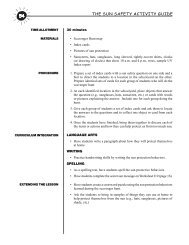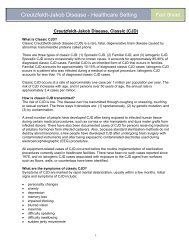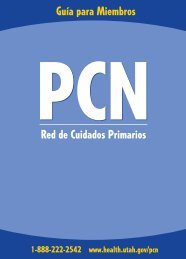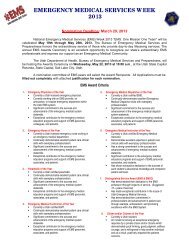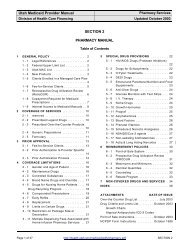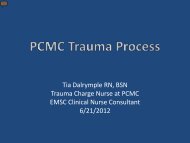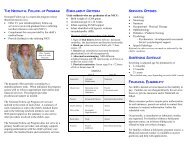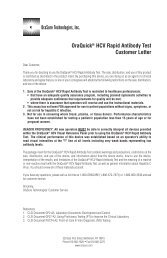Kennecott Berm Dust Exposure - Utah Department of Health - Utah ...
Kennecott Berm Dust Exposure - Utah Department of Health - Utah ...
Kennecott Berm Dust Exposure - Utah Department of Health - Utah ...
Create successful ePaper yourself
Turn your PDF publications into a flip-book with our unique Google optimized e-Paper software.
<strong>Berm</strong> <strong>Dust</strong> from <strong>Kennecott</strong> Retaining Pond<br />
In January 2012, the Environmental Epidemiology Program (EEP), <strong>Utah</strong> <strong>Department</strong> <strong>of</strong> <strong>Health</strong><br />
received an inquiry from a concerned citizen regarding possible negative health effects from inhalation <strong>of</strong><br />
berm dust from <strong>Kennecott</strong> mine tailing evaporation ponds. The citizen reported that each time they drove<br />
through the dust along Interstate 80 (I-80) they experienced malaise and sore throat for 2 to 3 days.<br />
Upon further inquiry by the EEP the citizen expressed concern regarding particulate matter from<br />
the berm surrounding the evaporation ponds. Concern centered on chemicals added to the water that was<br />
sprayed onto the berm to inhibit dust and promote plant growth. Another concern was where Rio-Tinto,<br />
<strong>Kennecott</strong>’s owner, obtained the fill material used to build, maintain, and extend the berm. The citizen<br />
inquired that if the material was obtained from mine waste material then the berm dust may include heavy<br />
metals. Finally, a concern was raised if the <strong>Utah</strong> Division <strong>of</strong> Environmental Quality or Rio-Tinto had ever<br />
quantified the amount <strong>of</strong> material lost <strong>of</strong>f the berm and to the north over the I-80 and into the Great Salt<br />
Lake.<br />
The <strong>Kennecott</strong> north tailings pond covers 3,560 acres. This accounts for 700 acres <strong>of</strong> the decant<br />
pond which is underwater, 2,000 acres <strong>of</strong> saturated beach, and 950 acres <strong>of</strong> tailings embankment (J.<br />
Sekulski-Barton, personal communication, February 14, 2012). The tailings pond parallels the southern<br />
edge <strong>of</strong> I-80 from a distance <strong>of</strong> 300 to 2000 feet for nine miles east <strong>of</strong> <strong>Utah</strong> State Route 202. From year<br />
2005 to 2010, about 27,000 vehicles and an estimated 40,000 people traveled this portion <strong>of</strong> I-80 each day<br />
(UDOT, 2011).<br />
As prevailing Wasatch front winds shift more consistently during the summer months, night and<br />
early morning winds are southerly and the direction reverses as the day progresses (UDEQ, 2011). Thus,<br />
berm dust blowing onto I-80 most likely occurs during the night and morning hours. It should also be<br />
noted that strong weather systems moving into the area can also generate southerly winds.<br />
The EEP contacted <strong>Kennecott</strong> and their response includes the following information: Tailings are<br />
the material remaining after crushing, grinding, and separating metals from the ore mined from Bingham<br />
Canyon. Mill tailings are separated into fine and course fractions after arriving at the impoundment. The<br />
fine fraction is moved to the saturated interior and the coarse fraction is directed to the perimeter <strong>of</strong> the<br />
impoundment where it is used to construct the impoundment dikes. The course fraction is similar in size<br />
and consistency to beach sand and is the material most likely to become airborne during high winds<br />
(Doughty, 2012).<br />
<strong>Kennecott</strong> sprays the tailings embankment with water and commercial dust suppressants. The<br />
current suppressant used is called HaulPro which is manufactured by Midwest Industrial Supply. The<br />
Materials Safety Data Sheet (MSDS) indicates the following: HaulPro is a light-brown colored liquid<br />
emulsion with a musty woodsy odor. It is formulated from pine rosin, pitch (tar-like substance), and<br />
water. Its pH ranges from 6 to 9. It is <strong>of</strong>ten diluted with water in ratios <strong>of</strong> 4:1 to 15:1 when applied.<br />
Misting <strong>of</strong> HaulPro may cause slight eye and respiratory irritation. It is relatively non-toxic to the<br />
digestive tract (Supply, 2006).<br />
Resources evaluating the metal concentrations in tailings and underlying soil were provided by<br />
<strong>Kennecott</strong> via an Environmental Impact Statement (EIS) prepared by the U. S. Army Corps <strong>of</strong> Engineers<br />
(U.S. Army, 1995). It lists data from sampling <strong>of</strong> the south tailings impoundment. <strong>Kennecott</strong> states that<br />
the data continue to be valid and representative <strong>of</strong> what the tailings materials contain today and will<br />
continue to store in the future. Results show that average metal concentrations <strong>of</strong> the constituents (arsenic,<br />
chromium, lead) in surface tailings were similar to those in average western soils except for copper. In<br />
addition, <strong>Kennecott</strong> does not measure the quantity <strong>of</strong> wind-blown material from the berm stating, “Given<br />
the similarity <strong>of</strong> tailings to average western soils, dust from the tailings would be nearly indistinguishable<br />
from dust originating from other sources, such as the interstate, beach material from the Great Salt Lake<br />
and dirt from agricultural and other fields” (Doughty, 2012).<br />
After reviewing the response from <strong>Kennecott</strong>, it is the EEP’s opinion that further studies<br />
identifying and quantifying those materials migrating from the pond berm onto the interstate during<br />
strong southerly winds are needed. This information would benefit both public health assessment and
<strong>Kennecott</strong>’s assessment <strong>of</strong> their dust suppression scheme. Without that data, the correlation <strong>of</strong> possible<br />
negative health effects from exposure to pond berm dust particulates cannot be adequately determined.<br />
Furthermore, the EEP recommends that concerned citizens take steps to protect their own health when<br />
driving through dust along this part <strong>of</strong> I-80 by closing vehicle windows and tops, recycling cabin air, and<br />
maintaining the inside air filter according to vehicle manufacturing suggestions.<br />
Prepared by:<br />
Alexander Wu, MPH<br />
Epidemiologist<br />
Craig J. Dietrich, Ph.D.<br />
Toxicologist<br />
Environmental Epidemiology Program<br />
<strong>Utah</strong> <strong>Department</strong> <strong>of</strong> <strong>Health</strong><br />
References<br />
Doughty, P. (2012). Response to Inquiry Regarding <strong>Kennecott</strong> Tailings. In A. Wu (Ed.) (Letter attached<br />
in email ed., pp. 2). Salt Lake City.<br />
Sekulski-Barton, J. (2012). <strong>Kennecott</strong> Follow Up Response. In A. Wu (Ed.) (Electronic mail). Salt Lake<br />
City.<br />
Supply, M. I. (2006). Haul Pro Material Safety Data Sheet.<br />
United States Army. (1995). Environmental Analyses and Technical Appendices for the <strong>Kennecott</strong><br />
Tailings Modernization Project, December 1995.<br />
<strong>Utah</strong> <strong>Department</strong> <strong>of</strong> Environmental Quality [UDEQ]. (2011). Modeling - Wasatch Front Winds. Salt Lake<br />
City. Retrieved. from. http://www.airquality.utah.gov/Planning/Modeling/images/Wind.htm.<br />
<strong>Utah</strong> <strong>Department</strong> <strong>of</strong> Transportation [UDOT]. (2011). Traffic Maps 2010 to 1998. Salt Lake City.



